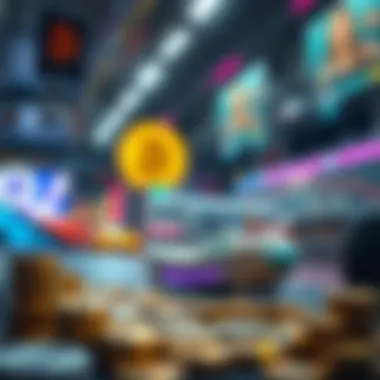Profitable Strategies for Earning with NFTs


Intro
Navigating the world of non-fungible tokens (NFTs) can often feel like wandering through a labyrinth without a map. However, the promise of monetizing digital assets—whether through art, music, or virtual real estate—makes this exploration worthwhile. With crypto markets continuously shifting and the world of blockchain expanding, it’s essential to grasp the foundational concepts and emerging trends guiding this newly minted frontier.
What’s at play here? Creativity, technology, and investment all come together under the broad umbrella of NFTs. It’s not just about owning a unique piece of digital art, but understanding the marketplace dynamics and the forces that can potentially drive up value. If you’re looking to dip your toes into NFT waters, it’s crucial to start your journey equipped with knowledge, strategies, and a keen sense of awareness for potential risks.
As we delve into this guide, we'll explore the trends influencing cryptocurrency, investment techniques, and the tools available for managing risks in this volatile yet exciting landscape. With the right approach, you can carve out a niche in the NFT marketplace and make money while doing what you love.
Let’s unravel these components step-by-step, providing you the insights you need to feel confident in your NFT endeavors.
Understanding NFTs
In the expanding vault of digital assets, non-fungible tokens, or NFTs, represent a pivotal frontier. They are a digital counterpart to unique physical items, often linked with artwork, collectibles, or any digital form requiring individuality. Many voices echo across forums and discussions emphasizing the significance of grasping how NFTs operate. This understanding doesn't merely offer a glance at the mechanics behind these tokens but provides a framework for participation in a novel economy that continues to transform artist-revenue models and investment strategies.
Definition of Non-Fungible Tokens
NFTs are unique identifiers that exist on a blockchain, linking them to an asset, be it digital art, music, virtual real estate, or even tweets. Unlike cryptocurrencies such as Bitcoin or Ethereum, which are fungible and can be exchanged on a one-to-one basis, each NFT is distinct. This peculiarity adds value in terms of ownership and appraisal, especially in fields where uniqueness dictates worth. Many collectors gravitate toward the sense of rarity NFTs offer, often diving into this space with the hope of both appreciation in value and the joy of holding one-of-a-kind pieces.
The Technology Behind NFTs
To comprehend NFTs fully, one must dive into the technology providing their backbone: blockchain. The strength and appeal of NFTs largely stem from their reliance on blockchain technology, smart contracts, and interoperability.
Blockchain Fundamentals
At its core, blockchain is a decentralized ledger policy maintaining a record of transactions across multiple computers. This decentralization proves crucial in establishing trust; without a single point of failure, it mitigates risks associated with fraud or data manipulation. A noteworthy characteristic of blockchain is its transparency. Each transaction can be traced back, offering a clear ownership history which becomes immensely important in establishing provenance for digital assets. However, it can also be a double-edged sword; while transparency builds trust, it may not always align with users seeking privacy.
Smart Contracts
Smart contracts, which are self-executing contracts with the terms of the agreement directly written into code, facilitate transactions involving NFTs without the need for intermediaries. This aspect is key to the efficiency of NFT interactions. By automating processes, smart contracts can reduce costs and processing times significantly. Nevertheless, reliance on smart contracts can introduce uncertainties. If there are flaws in the code, the consequences can be dire—financial loss or failure to uphold the terms of the agreement can become hurdles for creators and buyers alike.
Interoperability
Interoperability addresses the capability of different blockchain networks to communicate and apply across systems. This quality becomes essential for NFTs as it allows them to function across multiple platforms and marketplaces. Imagine an artwork minted on one platform and later sold on another. This seamless movement not only enhances user experience but also widens market opportunities. Yet, interoperability isn't without its challenges. Compatibility issues among different blockchains can serve as roadblocks, necessitating technological advancements to ensure smooth functioning throughout the ecosystem.
"The integration of NFTs within a diverse array of platforms can facilitate unprecedented commercialization opportunities, linking creators directly to their audience."
In understanding the full spectrum of NFTs, including their definition and the technology behind them, one begins to grasp their potential and how this uniquely impacts the world of digital assets. As these tokens find their way into various sectors, recognizing their underlying mechanics becomes crucial for anyone looking to navigate the waters of this burgeoning market.
The NFT Marketplace Landscape
The NFT marketplace landscape is pivotal for anyone looking to delve into the world of non-fungible tokens. This is where creators and buyers come together, facilitating the exchange of digital assets. Understanding this space helps in navigating the financial opportunities presented by NFTs.
Moreover, the myriad of platforms available can directly affect the visibility and perceived value of your NFTs. The choices regarding where to sell can determine the success of your digital asset strategy.
Key NFT Marketplaces to Explore
When discussing marketplaces, notable players dominate the scene. Each platform has its own unique traits that cater to different audiences and types of digital assets.
OpenSea
OpenSea stands out as one of the most significant names in the marketplace realm. It boasts a vast selection of NFTs across various categories like art, collectibles, and gaming. Its key characteristic is the sheer volume of options available, allowing for an expansive user experience.
A notable feature of OpenSea is its user-friendly interface that enables even the newest users to mint and list their works with ease. This attribute often attracts artists and creators looking to jump in without the complexities. However, the platform has faced some criticism regarding scalability and high transaction fees during peak times, which can hinder transactions.
Rarible
Rarible brings another flavor to the NFT space, focusing heavily on community governance. Here, users can vote on platform features and changes, giving a sense of ownership among its users. This key characteristic fosters engagement and community-driven innovation.
Unique to Rarible is its ability to facilitate the creation of both ERC-721 (individually unique tokens) and ERC-1155 (multi-token standards) NFTs. While this can enhance flexibility for creators, the lack of oversight may lead to issues like copyright infringement, making it a double-edged sword.
Foundation
Foundation positions itself as an exclusive venue, mainly catering to artists and creators who produce high-quality digital art. It's a popular choice because of its curated environment, ensuring that the showcased artwork maintains a level of prestige.
The platform encourages limited drops, allowing artists to sell only a certain number of pieces at once, creating a sense of urgency and value among collectors. Yet, it might not be for everyone, as the necessity of bringing in a member to invite you can pose barriers for emerging creators seeking exposure.
Understanding Market Dynamics
Understanding the dynamics of the NFT market is crucial for anyone looking to succeed in this space. Various factors play into how assets are priced and traded.
Supply and Demand Factors
Supply and demand in the NFT market often drives pricing. With limited editions or unique pieces, scarcity becomes a significant driver of value. Conversely, an oversaturated market can dilute the worth of individual tokens, leading to lower prices. This relationship underscores why market research is essential for potential sellers and buyers alike.
It's important to stay attuned to trends within the community. An artist gaining traction can lead to increased demand for their previous works. Thus, keeping tabs on trending creators is beneficial.
Price Volatility
Price volatility represents another critical aspect of this market. NFTs can see dramatic changes in value, sometimes within hours. This key characteristic offers opportunities for savvy investors to buy low and sell high but also carries risks.


The uniqueness of NFTs adds to this volatility. For instance, a particular hype event can elevate the price of a previously low-valued token quickly, only for it to drop back down later. Therefore, being cautious and patient is essential when entering this unpredictable landscape.
Market Trends
Staying ahead of market trends can set an individual apart in the competitive NFT realm. Emerging trends, such as preferences for particular art styles or shifts toward eco-friendly NFTs, often determine which projects garner interest.
Having a finger on the pulse of the market can aid in making informed decisions. Whether you are an artist deciding on your next creation or an investor looking for the next diamond in the rough, understanding trends is invaluable. Being proactive rather than reactive in this fast-paced environment is the way to go.
Creating Your Own NFTs
Creating your own non-fungible tokens (NFTs) represents a pivotal step in the digital marketplace. The ability to tokenize your digital assets not only broadens your reach but also allows you to engage directly with a global audience. Whether you are an artist wanting to showcase your creations or a gamer keen on selling in-game items, crafting your own NFTs opens up a slew of opportunities.
The growth of the NFT space is explosive; therefore, grasping the intricacies of creation is crucial. Each NFT carries a unique value, representing ownership of a specific digital item. The sheer variety in the forms NFTs can take—from art and music to virtual land and collectibles—adds a layer of excitement. Creators can effectively monetize their work while retaining some control over how their items are used post-sale.
Choosing the Right Platform
User Interface Considerations
When selecting a platform to create NFTs, the user interface can greatly impact how smoothly the process goes. A straightforward, intuitive interface simplifies the learning curve for newcomers, helping them to navigate their options with ease. Platforms like OpenSea and Rarible provide a user-friendly experiences that allows creators to manage their endeavors without getting lost in tech jargon.
One key characteristic is accessibility. If a platform boasts an easy-to-navigate dashboard, you’ll find it easier to upload, create, and list your digital assets. However, a downside can be that overly simplified interfaces might omit some advanced features creators may find useful, so striking a balance is essential.
Transaction Fees
Transaction fees can play a significant role in the overall cost of minting NFTs. Each time a transaction occurs, platforms often charge fees that can either be a flat rate or a percentage of the sale. These fees are necessary to pay for network costs but can eat into profits if not carefully considered.
An important feature of transaction fees is that they can vary widely among platforms. For instance, platforms like Foundation may have higher fees, but they often attract a more targeted audience looking for curated content. Conversely, lower fee platforms can attract higher volumes of trades but might compromise on quality. It’s a balancing act and being mindful of these fees is crucial for profit maximization.
Supported Formats
NFTs can represent various digital formats, and different platforms may support diverse types. Whether it’s images, music files, or even virtual real estate, knowing the formats supported by your chosen platform is paramount.
This characteristic of supported formats allows creators to leverage their existing digital content seamlessly, making it easy to convert existing works into NFTs. However, artists should research ahead as each platform carries limitations that could restrict your creative options. For instance, some may support only certain image formats like PNG or JPEG, while others also allow GIFs or 3D models.
Steps for Minting NFTs
Designing the Digital Asset
The process of designing a digital asset is foundational to NFT creation. This aspect determines not only what your NFT will look like but also how it will resonate emotionally with potential buyers. Art is subjective, so finding a style that speaks to your target audience is rather important. Whether it’s vibrant colors or muted tones, your design choices will play a significant role.
A unique feature in designing your digital asset is the opportunity for storytelling. Engaging designs often incorporate narrative elements that can draw in collectors. But watch out! Overcomplicating your designs may dilute their impact.
Setting Metadata
Setting metadata involves including essential information such as title, creator details, and unique attributes of your digital asset. This information is crucial in distinguishing your NFT from others in a crowded marketplace.
The key characteristic here is the ability to customize metadata to suit your creative vision. Including detailed descriptions and keywords can enhance visibility when buyers are searching for NFTs. While there are many opportunities to enrich metadata, keep it focused to avoid overwhelming potential buyers with information.
Minting Process
Minting is the actual act of creating an NFT on the blockchain. It transforms your digital file into a token that is tradable and verifiable. This technical step is critical as it defines how your asset will be perceived in the marketplace.
A unique feature of the minting process is the interaction with smart contracts. Understanding how these function is fortunate because they automate several aspects of transactions. However, being new to blockchain, creators might find the technicalities a little daunting. Make sure to read up on this segment—it could save you a world of trouble in the future.
Monetizing NFTs
Monetizing NFTs represents a pivotal aspect of the broader conversation surrounding non-fungible tokens. While the creation and ownership of NFTs garner much attention, the real conversation starter is how artists and investors can turn their digital assets into tangible income. At its core, monetizing NFTs encompasses various strategies such as direct sales, auctions, royalties, and secondary sales that, when executed correctly, can lead to meaningful financial returns.
The importance of this topic cannot be overstated. Understanding how to monetize NFTs effectively allows creators to access opportunities that were previously out of reach. It bestows power upon individuals to dictate their economic potential rather than rely solely on external influences or traditional markets. More importantly, success in this area hinges not just on creativity, but a keen sense of market dynamics and economic foresight. With the right approach, the digital art landscape evolves beyond mere expression into a viable source of revenue.
Direct Sales vs. Auctions
When diving into the world of NFT monetization, one of the first dilemmas creators face is the choice between direct sales and auctions. Both methods offer distinct pathways to cashing in on NFTs, each with its own merits and considerations.
Advantages of Direct Sales
Direct sales present a straightforward and immediate way to profit from NFTs. This method is primarily characterized by fixed pricing, allowing buyers to purchase NFTs at a set amount without the uncertainties often linked to auctions. For many creators, this approach reduces stress significantly. It's akin to having a firm handshake instead of risking a bidding war.
The primary appeal lies in its predictability, making it a particularly advantageous option for those new to the NFT space. However, one downside is that it limits the price to the amount that an individual is willing to pay, potentially undervaluing an asset. The market can sometimes reward sellers much more in a high-stakes auction environment where bidders might compete for their work, thus inflating the final sale price.
Strategies for Successful Auctions
On the other hand, auctions open a realm of possibilities for creators willing to gamble a bit on their NFTs. This method thrives on the principle of competitive offering. The fierce bidding can drive prices up significantly above a creator's expectations, translating into greater profit margins. The thrill of real-time action, coupled with the unpredictability of buyers willing to outlast each other, can yield high returns.
To set the stage for success, artists should focus on promoting their work ahead of the auction. Leverage social media and utilize platforms frequented by potential buyers, creating buzz about the upcoming auction. An effective strategy might include engaging storytelling about the NFT's value and its creation process. In contrast, auctions also come with their own risks. Not all auctions yield desirable results; an unfavorable bid can lead to an unsatisfactory sales outcome. Here, shrewd acumen and market awareness play a critical role in determining the right timing and target audience.
Royalties and Secondary Sales
When discussing the potential for monetizing NFTs, royalties and secondary sales take center stage. These concepts contribute significantly to ongoing earnings potential long after the initial sale has taken place.


Understanding Royalties
Royalties are a hallmark of the NFT sector, offering creators the unique ability to earn a percentage of future sales whenever their NFT changes hands. This model is revolutionary and signifies a departure from traditional art sales, where artists receive payment only once upon the original sale. With royalties, creators are compensated for their work each time their NFT is sold, establishing a continuous income stream. This characteristic elevates NFTs beyond mere collectibles and underscores the economic potential housed within digital creativity.
Nevertheless, understanding the fine print of royalty agreements is essential. Different platforms offer varying percentages and conditions. Some might have limits that could affect how much creators ultimately earn. Factors such as platform fees can also cut into these earnings.
Long-term Income Potential
Long-term income potential from NFT royalties is a significant draw for many artists. Unlike trends that may fade, high-quality work can retain or even increase its value over time. This can contribute to a sustainable income flow for creators, particularly as the demand for digital assets grows in different markets.
However, it's crucial to approach this with a sense of realism. Not every NFT will become a sought-after piece in the years to come. Creators must continuously evaluate their assets and maintain their connection with the community. Engaging with existing fans and attracting new ones becomes vital for the support and longevity of their work's value in this evolving marketplace.
Investment Strategies in NFTs
Navigating the world of NFTs isn't simply about buying and selling; it's about smart investment strategies that can yield fruitful returns. In this section, we will highlight the importance of specific investment approaches that enhance the likelihood of success. These strategies will allow informed decisions, minimizing the risks while maximizing potential rewards. With the NFT market continuously evolving, a strategic mindset is essential for anyone wanting to dive into the NFT investing realm.
Identifying Valuable Projects
Evaluating Project Teams
When determining the viability of an NFT project, the strength and credibility of its project team can’t be overlooked. A strong team usually reflects a solid foundation for the project's success. Key characteristics like their professional background, previous achievements, and industry reputation stand out. A team that has demonstrated prior success in blockchain or tech ventures is often perceived as a safer bet.
However, it’s crucial to do your homework. Engaging with community feedback and checking social media presence can give insights into how the project team interacts with both users and investors. Projects led by experienced teams tend to rally more community support, thus reinforcing their potential value in the market.
"The team behind the project is sometimes just as important as the project itself."
Nonetheless, it's worth mentioning that a strong team does not guarantee success, as market conditions could sway the project's outcome. However, having a capable team certainly tilts the scales in favor of stability.
Community Engagement
Community is the backbone of any NFT project. Engaging with a dedicated and passionate community brings more visibility and traction. This characteristic is crucial; projects that actively interact with their community tend to gain trust and loyalty from their investors. An actively engaged community often supports projects during market downturns, leveraging collective strength.
Exploring platforms like Discord and Twitter can reveal levels of engagement, including discussions, community governance, and collaborative activities. These interactions can also showcase how responsive the project is to feedback and suggestions from its community. However, it can be a double-edged sword; while a vibrant community attracts interest, it can also inflate expectations that may soar higher than the project can practically deliver.
Artistic Value
Artistic value encompasses aesthetic appeal, uniqueness, and emotional resonance within the NFT space. A project boasting strong artistic elements can often create significant buzz. Unique designs or innovative art moves can elevate values, especially if backed by a reputable artist. Recognizing artistic value requires not just an eye for design but also an understanding of market preferences.
Investors looking for projects with high artistic value usually analyze details such as historical relevance, artist recognition, or even cultural significance. Whether a piece elicits emotion or gives a nod to contemporary trends can dictate its demand. However, be wary of trends; the art world can be fickle, and what may seem valuable one day could lose its luster the next.
Diversification and Portfolio Management
Balancing Risk and Reward
Balancing risk and reward is a vital component of any investment strategy. Particularly in the NFT market, where volatility can be rampant, finding that sweet spot is a fundamental practice. Investors often assess their risk tolerance—understanding how much they are willing to lose versus the potential gain is paramount.
Risk can diminish through constant market analysis, understanding project lifecycles, and perhaps most importantly, staying diversified. Investing in a range of projects across different genres or themes can protect against significant losses if one part of the portfolio doesn’t perform well. Nevertheless, keep in mind that over-diversification might dilute potential returns. It’s essential to find a balance that aligns with your investment goals.
Asset Allocation Techniques
Deciding on effective asset allocation techniques means determining what percentage of your portfolio to dedicate to NFTs versus other investments. This decision relates closely to your financial goals, risk appetite, and the current market environment. Investors often analyze historical performance data and market trends to make informed decisions about how to spread their assets.
Utilizing techniques like the "60/40" portfolio strategy, for instance, could involve holding 60% in traditional assets and 40% in NFTs. This style can provide a buffer while still affording significant growth potential from the NFT segment. Ultimately, tailoring your asset allocation plan to your personal circumstances is key; what works for one investor may not suit another. Finding your own technique can lead to maximizing potential returns while protecting oneself against downturns in the NFT landscape.
Understanding these elements not only broadens your strategy but adds a layer of confidence as you step further into the intricacies of the NFT market.
Risks and Challenges in the NFT Space
As exciting as the world of non-fungible tokens is, it comes with its share of risks and challenges. It's crucial for anyone looking to make money with NFTs to recognize these factors, as they can significantly impact one’s investments and creative journeys. Gaining insights into the risks, from market fluctuations to legal intricacies, equips you with knowledge that can protect your interests and enable strategic decision-making.
Market Risks
Market risks are a fundamental concern in the NFT space. These risks often stem from the volatile nature of prices and demand for digital assets. Understanding how these elements work can help you avoid losses while maximizing your potential for profit.
Price Fluctuations
Price fluctuations in the NFT market can be wild and unpredictable. One day a piece of digital art could sell for thousands, and the next, it might be worth a fraction. This volatility mainly results from market speculation and news cycles that can shift enthusiasm in the blink of an eye. Being aware of this characteristic is essential; it serves as a reminder to not get swept up in the hype.
The highlighted feature of price fluctuations is its dual nature: while it can lead to significant profits for some, it can cause substantial losses for others. In clearly understanding how prices fluctuate, you can draft a more informed approach towards when to sell or hold your assets based on market trends.
Liquidity Concerns
Liquidity in the NFT market can be a dicey game. Not every NFT will have a ready pool of buyers, which means your carefully crafted digital masterpiece could sit unsold for a long time. This can be particularly frustrating for investors who may need to cash out quickly.
The key characteristic of liquidity concerns lies in the lack of immediate buyers for certain types of NFTs. In simpler terms, it’s not always possible to sell when you want, potentially leaving you in a tough spot if the market shifts. Knowing this can help you strategize better and ensure that you don’t tie up too much investment in illiquid assets.
Technical Risks
Technical risks often arise from the very technologies powering NFTs. While blockchain offers unmatched security, it's not infallible. Understanding these risks can set you on the right path, allowing for informed engagement in the space.


Smart Contract Vulnerabilities
Smart contracts are the backbone of NFT transactions, but they come with vulnerabilities that can lead to losses. Coding errors, security loopholes, and other technical flaws could be exploited, leading to loss of assets or funds. Recognizing the inherent risks tied to smart contracts indicates the importance of due diligence when engaging in NFT projects.
A notable feature of smart contract vulnerabilities is that they are often complex and invisible to the average user, which can result in catastrophic financial impacts without prior knowledge. This complexity means a cautious approach is warranted; dig deep into the technology behind your NFTs to mitigate any potential issues.
Platform Reliability
The reliability of various NFT platforms is another technical risk to be aware of. Not all platforms have the same level of security or user support. This inconsistency can lead to challenges during transactions, causing everything from delayed sales to losses in digital assets.
Platform reliability can be a mixed bag. It can allow for a seamless experience on well-established platforms but might leave investors stranded on less-known sites. Checking the reliability of your chosen platforms is crucial to make sure the risk is minimal.
Legal and Regulatory Considerations
With NFTs continuing to evolve, legal and regulatory considerations are becoming more prominent. Keeping abreast of these matters not only helps prevent legal trouble but also allows you to approach investments strategically.
Intellectual Property Issues
Intellectual property issues are a rising concern in the NFT universe. Artists selling their work may inadvertently infringe on others' copyrights, and buyers could find themselves owning tokens of assets they do not have full rights to. This risk can create an array of legal complications, from possible lawsuits to financial losses.
This characteristic of intellectual property in NFTs is what makes it vital to understand the rights associated with any token you purchase. Do your best to research if you're the rightful owner of an asset before making any financial commitments in order to safeguard your investment.
Tax Implications
Tax implications are another daunting aspect of investing in NFTs. These digital assets often defy traditional categories, leading to confusion over how and when they will be taxed. The ambiguity surrounding the taxes on NFT transactions can catch even the most seasoned investors off guard.
The unique feature of tax implications in the NFT realm primarily lies in their unpredictability. Different countries approach NFT taxation in various ways, which can complicate matters significantly. Keeping up with the ever-changing tax regulations can help prepare you for potential liabilities as you navigate your NFT investments.
Navigating through the risks and challenges is essential for anyone serious about making money with NFTs. Awareness of these factors allows for talent growth, smart investing, and a better chance to truly succeed in the ever-evolving NFT landscape.
Future Trends in the NFT Market
The world of NFTs is changing faster than a cat on a hot tin roof. As the market matures, it’s crucial to keep an eye on future trends that can shape your approach to making money with these digital assets. Understanding emerging technologies and sustainability is not just a nice-to-have in this arena; it’s a must. With the rapid evolution of both the market and technology, being aware of these trends could end up being the difference between riding the wave or getting washed away.
Emerging Technologies
Augmented Reality
When we talk about Augmented Reality (AR), it’s not just about pretty pictures overlaying the real world, though that’s part of the fun. AR brings a new dimension to NFTs by allowing users to interact with digital assets in a way that feels genuine. For example, imagine an NFT art piece that can be viewed in your living room, seamlessly blended with your actual decor.
One of the standout characteristics of AR is its interactivity. Unlike static images or video files, AR can create immersive experiences that captivate the audience. This feature makes AR a popular choice for artists and brands looking to sell NFTs. It adds a layer of engagement that simple images just can't match. However, there can be challenges with accessibility as not all users may have the necessary tools to fully enjoy these AR experiences, reducing the overall potential audience.
Virtual Reality
Virtual Reality (VR), on the other hand, enables a complete immersion in digital worlds. Think of VR as your personal spaceship into a universe devoid of limits. For NFT creators, VR can host intricate galleries where users can wander around 3D representations of their art. This makes VR a strong contender in the NFT landscape.
The unique feature of VR is the sense of presence it creates. People don’t just see the art; they feel as if they are inside it. This characteristic can draw collectors in like moths to a flame. But it’s not all sunshine and roses. On the downside, VR requires specific hardware, which could limit user engagement. A savvy creator, however, can find ways to lower these barriers and still thrive in the VR ecosystem.
Sustainability of NFTs
As much as the allure of NFTs can snag the attention of collectors and investors alike, there are growing concerns about their environmental impact. With digital assets relying heavily on blockchain technology, the energy consumption associated with minting and trading NFTs can be staggering. This brings a critical focus on sustainability within the NFT space.
Environmental Impact
The environmental impact of NFTs has been hot on the heels of critiques. Many traditional blockchains, like Ethereum, operate on energy-intensive proof-of-work systems. Simply put, minting an NFT can sometimes leave a bigger carbon footprint than some small countries. This vital aspect contributes to growing skepticism about the NFT market among eco-conscious investors. While there are efforts to address this, the challenge remains in finding balances between innovation and environmental responsibility.
Green Alternatives
Fortunately, the narrative is not just bleak.
Green alternatives are beginning to emerge in the NFT space. These platforms utilize energy-efficient blockchains or incorporate carbon offsetting strategies. One notable example is Tezos, which has successfully positioned itself as an eco-friendly option for moth artists and collectors. The key characteristic here is sustainability through technology. Adopting these green alternatives could not only mitigate environmental impact but also attract a new wave of ethical investors into the NFT world.
The unique feature of green alternatives is that they promote a sustainable approach while still enabling creators to monetize their talents. However, while the transition shows promise, it also raises the question—will the traditional platforms get on board, or will they continue to resist this crucial change?
In summary, understanding future trends like emerging technologies in AR and VR, as well as sustainability efforts through green alternatives, provides invaluable insights for traders and investors in the NFT sphere. Remaining adaptable to these trends can enhance your strategies and keep you one step ahead of the crowd.
End
The world of NFTs is like riding a wild horse—fast, exhilarating, but definitely requiring a good grip. The conclusion of this article serves not merely as a wrap-up but as a pivotal moment of reflection on the essential points discussed throughout.
NFTs can be lucrative, but like every goldmine, one must tread carefully. The potential for earning money by creating, buying, and selling NFTs is immense, yet it comes intertwined with risks that range from market volatility to technical vulnerabilities. Recognizing these factors is crucial for anyone looking to make their mark in the NFT arena.
Key Takeaways for NFT Enthusiasts
With the landscape constantly changing, keeping key takeaways in mind can serve as a compass for enthusiasts:
- Do Your Homework: Knowledge is valuable currency. Familiarize yourself with standout marketplaces like OpenSea or Rarible. Understand what makes a project tick.
- Foster A Unique Identity: Create NFTs that resonate with your personal brand or aesthetic. Authenticity often trumps conformity in this digital space.
- Monitor Market Conditions: Keep a close watch on trends and price movements. Awareness can give you an edge during buying or selling moments.
- Network: The NFT community thrives on collaboration. Engage with other creators, buyers, and investors to expand your reach and understanding.
Continued Learning and Adaptation
The journey into the NFT world doesn’t end here. In fact, it’s just the beginning. Adaptability is key, as technology continues evolving. Keeping pace with innovations like augmented reality or changes in user preferences is vital.
- Follow Industry Trends: Subscribe to NFT-specific newsletters, engage in forums on Reddit, or participate in discussions on Facebook groups to stay informed about the latest developments.
- Experiment: Don’t be afraid to test the waters. Trying out different forms, such as game assets or music NFTs, can provide fresh insights and opportunities.
- Feedback Loop: Engage with your audience or collectors for feedback on your work. This interaction can often lead to unexpected growth.
In summary, with a combination of knowledge, creativity, and a willingness to learn, anyone can dive into the world of NFTs and potentially unlock new avenues for income. Given the fast-paced evolution of this digital frontier, those who take the initiative to adapt will be the ones who thrive.







